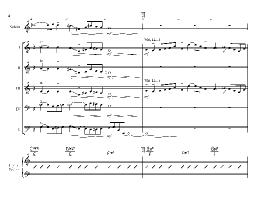

@roger-aldridge
Mid-Size Jazz Ensemble

I am a fan of the mid-size ensemble and the creative possibilities it offers.
2008 was a transition time for me. I had become tired of conventional big bands. As I looked for something different, ideas came to me about a smaller and more flexible kind of band. I experimented first with a 10-piece ensemble (electric violin and tuba were featured). While this group had only a short life as a rehearsal band, hearing the scores I wrote for it gave me a confirmation of the direction I was taking.
As a next step, I began to use flexible instrumentation in my scores instead of specifying the instruments. The scores are concert pitch with the wind instruments labeled as line I, line II, etc. A set of transposed parts are provided for an assortment of instruments within the range of each line. This enables the music to be performed by many configurations of instruments. An ensemble can have a specific instrumentation, experiment with different instruments, or base the instrumentation on available players. Flexibility!
One of the ensemble configurations that I like is alto flute, oboe, clarinet, French horn, and bassoon. That is, a woodwind quintet with alto flute used in place of C flute. Rather than thinking of a mid-size ensemble as a smaller version of a big band, I envision a woodwind quintet – that is, with each instrument having a distinct tone color – as a role model. Another configuration that I like (this one with saxophones and brass) is trumpet, soprano sax, alto sax, trombone, and tuba. With flexible instrumentation and a creative spirit, the tone color possibilities for an ensemble can be almost endless.
For the rhythm section, piano and/or guitar, bass, and drums are the foundation. It can be expanded with additional instruments such as accordion, vibes, percussion, electronics, cello, etc.
Along with flexible instrumentation, I decided that it would be more practical to use 5 or 6 wind instruments than a larger number for a horn section. 5-horn jazz ensembles are fairly common. I have several scores for 5 horns; however, I think of 6 horns as being the optimal number for my writing. My 6-horn scores are written for a featured soloist, 5 wind instruments, and rhythm section. The soloist has both solo and ensemble roles.
As my concepts evolved for a mid-size ensemble I discovered that, from my perspective, I can be more creative in writing for 6 horns than for a conventional big band. Why? With one player on a line, each line can have an individual tone color. Then, the 6 lines are blended, juxtaposed, crossed, and voiced in creative ways horizontally and vertically. This creates an ensemble sound that is based upon an interplay of colors and an emphasis on the individuality -- bringing out the musical personality -- of each player.
As I envision it, this approach to an ensemble is fundamentally different from what I think of as the defining features of a conventional big band: harmonized saxophone, trumpet, and trombone sections with each player blending his individual sound into the collective sound of a section.
Additionally, with an ensemble of this size it can have a level of creative freedom that, most likely, would be problematic with a larger number of players. I like to extend a jazz soloist's freedom to the rest of the ensemble in various ways in my scores. This enables the music to change, evolve, and be a fresh experience for both the musicians and the audience each time it is performed.
While I have focused on 6 horns and one player on a line, it occurred to me that my scores can also be played by larger ensembles by having two (or more) musicians on each line . This option of having doubled parts -- with either same or different instruments on a part -- is an easy way for big bands to use my scores. (See A Big Band Misconception for more about this idea.)

awesome
Thanks! The Youtube section of my profile has 7 videos that sync a demo recording with the score pages. That way, one can listen to the recording and follow the score. Each of these scores has a different style. They are good examples of how I use different kinds of harmonic voicings, line writing, orchestration, etc. In one way or another, each one also has a good amount of humor.